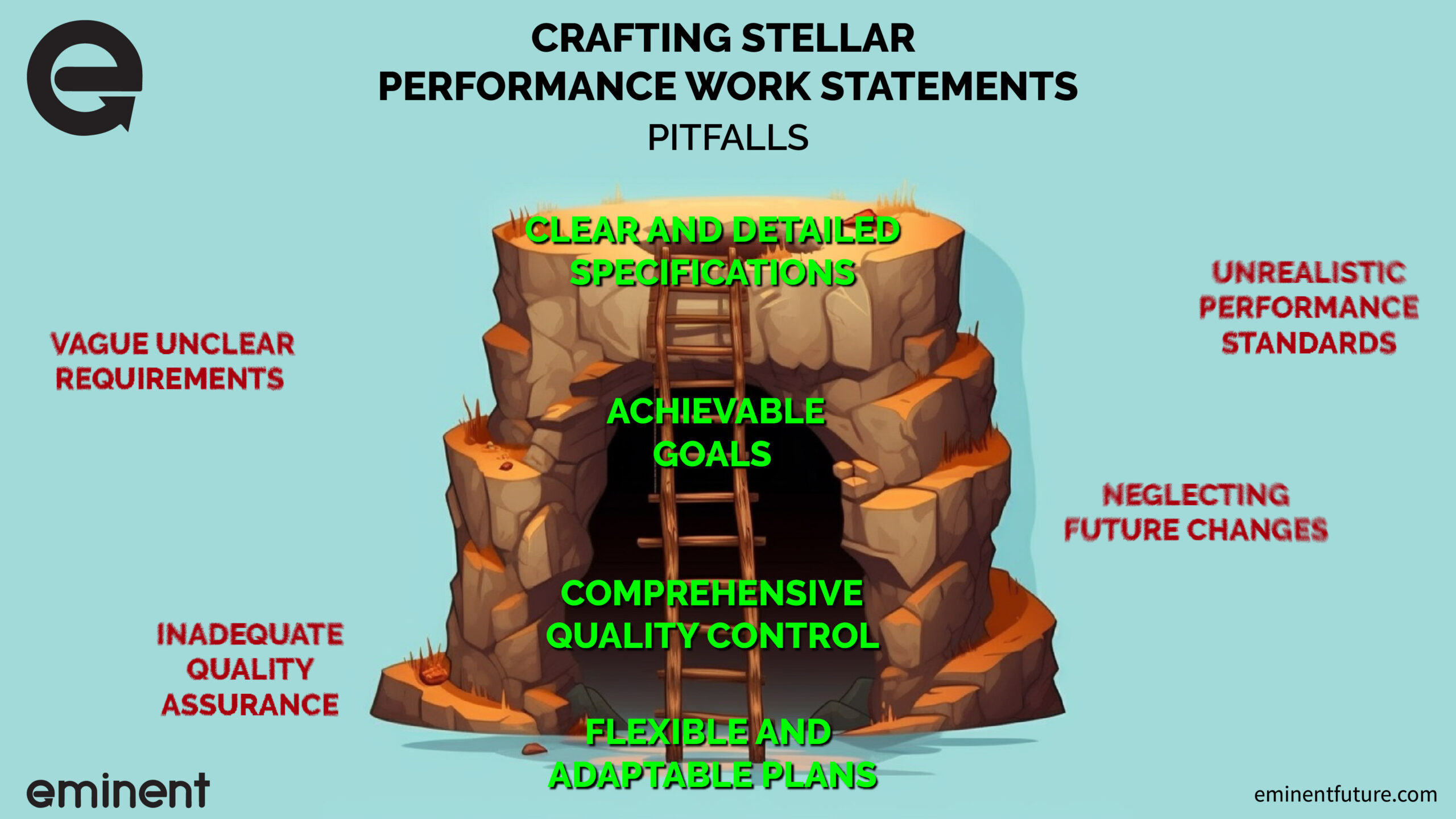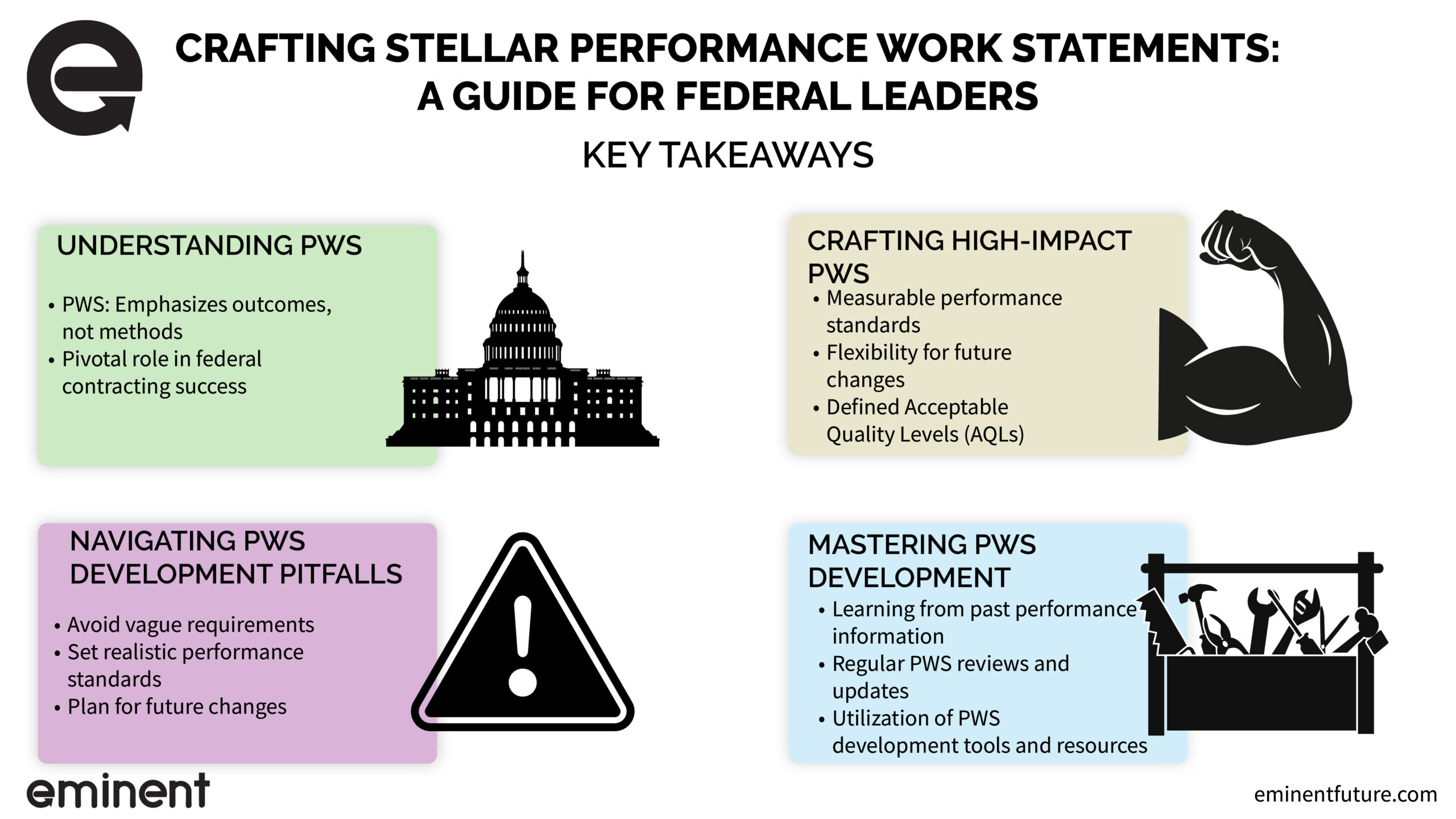
In the ever-evolving landscape of federal contracting, Performance Work Statements (PWS) have emerged as a cornerstone for success. These vital documents outline the expected outcomes of contracts, providing a clear roadmap for vendors while ensuring that federal agencies’ needs are met.
But developing an effective PWS is no simple task. It requires careful consideration, meticulous attention to detail, and a deep understanding of the project at hand.
This guide serves as a comprehensive resource for federal directors, providing insight into the intricacies of PWS and offering practical strategies for crafting these crucial documents with confidence and proficiency.
Performance Work Statements Demystified

Understanding Performance Work Statements
Performance Work Statements (PWS) serve as the heart of performance-based contracts within the federal government. They clearly and concisely describe the required outcomes, giving vendors a thorough understanding of the government’s expectations. The PWS is not about prescribing how the work is to be done but emphasizes the end result.
Anatomy of a Well-Structured Performance Work Statement
A comprehensive PWS is composed of several vital elements. This typically includes the scope of work, deliverables, performance standards, quality assurance measures, and any specific limitations or constraints.
Each part plays a vital role in creating a mutual understanding between the federal agency and the contractor, fostering a productive, goal-oriented relationship.
The Pivotal Role of PWS in Federal Contracting
Performance Work Statements significantly influence the success of federal contracting. They streamline the contract awards process by providing clarity and transparency and facilitating the management and evaluation of contract performance.
An effectively written PWS helps mitigate risks, reduce misunderstandings, and promote accountability, thereby contributing to the overall efficiency and effectiveness of federal projects.
Crafting High-Impact Performance Work Statements

Identifying and Clearly Defining Requirements
The first step towards developing a powerful PWS is identifying and clearly articulating your requirements. These requirements should outline the expected outcomes, not the methods or processes to achieve them.
By focusing on ‘what’ rather than ‘how,’ you allow vendors the freedom to innovate and propose creative solutions, potentially leading to more efficient and effective service delivery.
Setting Measurable Performance Standards
Performance standards are critical to a PWS as they set the criteria for acceptable performance. These standards must be measurable and quantifiable, ensuring a director can assess the contractor.
These could include timelines for deliverables, quality expectations, or specific metrics related to the provided services.
Incorporating Flexibility for Future Changes
The needs of federal agencies can change over time due to shifts in legislation, policy, or strategic objectives. Therefore, an effective PWS should incorporate flexibility to accommodate future changes.
This effect can be achieved by including provisions for contract modifications, ensuring that the contract can adapt to changing circumstances without compromising its overall objectives.
Defining Acceptable Quality Levels (AQLs)
AQLs establish the minimum level of service acceptable for each critical performance element in the PWS. They are a benchmark for assessing the contractor’s performance and determining whether they ultimately meet their obligations.
Defining AQLs in the PWS helps to ensure that the contractor is fully aware of the quality standards they need to meet or exceed.
Ensuring Compliance with Federal Regulations
Lastly, a PWS must comply with all relevant federal regulations and guidelines. Such considerations include procurement policies, security requirements, environmental regulations, and more. Compliance ensures that the contract is legally sound and helps to avoid potential issues down the line.
Collaborating with legal and procurement experts is advisable to ensure your PWS meets all necessary regulatory requirements.
Navigating Potential Pitfalls in PWS Development

Vague or Unclear Requirements
One of the most common pitfalls in developing PWS is having vague or unclear requirements. Ambiguous requirements can lead to misunderstandings, missed expectations, and disputes between the federal agency and the contractor.
To avoid this, ensure your needs are explicit, detailed, and understandable. Use clear, concise language and avoid jargon whenever possible.
Unrealistic Performance Standards
Setting unrealistic performance standards is another common mistake. While it’s crucial to maintain high standards, they should also be attainable based on the resources and timelines provided.
Unrealistic expectations can lead to contractual disputes, underperformance, or failure to deliver. It is essential to balance your desire for high-quality outcomes with a realistic eye toward what is possible.
Inadequate Quality Assurance Provisions
Quality assurance is vital to any contract, ensuring that the services or products delivered meet the defined standards. Inadequate quality assurance provisions in the PWS can lead to subpar results and contract non-compliance.
It’s essential to include robust quality assurance procedures in your PWS, detailing how performance will be evaluated and what happens if standards are not met.
Neglecting Future Changes
As previously mentioned, the needs of federal agencies can change over time. A common pitfall is neglecting to account for these potential changes when developing a PWS.
Ensure your PWS includes provisions for contract modifications and updates, ensuring it can adapt to changing circumstances while still fulfilling its overall objectives.
Mastering PWS Development: Best Practices

Forging Strong Collaborations
Collaboration is key in the Performance Work Statement (PWS) development. Engaging with all pertinent stakeholders, including team members, end-users, contractors, and other parties involved in the project, can yield a more comprehensive and practical PWS.
By fostering an environment that encourages open communication, you can ensure that the PWS reflects all parties’ diverse needs and expectations.
The Past as a Blueprint
Leveraging past performance information can serve as an invaluable tool for federal directors. By analyzing previous projects and their respective PWS, you can identify what worked well and what didn’t, which can inform your current PWS development process.
Consider examining the clarity of requirements, the effectiveness of performance standards, or the suitability of quality assurance provisions.
The Power of Regular Reviews
PWS is not a one-and-done document. Reviewing and updating the PWS regularly is essential to accommodate changes in project scope, requirements, or federal regulations.
By maintaining an up-to-date PWS, you can ensure that the contract continues to meet its intended purpose and supports the successful execution of the project.
Key Takeaways

The Next Chapter: Advancing PWS Development in Federal Leadership
Numerous resources and tools are available to aid in developing a robust PWS. These can range from templates and guides to software applications designed specifically for PWS development. Utilizing these tools can streamline the process, reduce errors, and result in a more effective and comprehensive PWS.
Mastering the art of Performance Work Statement development is a journey, not a destination. As federal directives, industry standards, and project scopes evolve, so too must our approach to crafting these integral documents. By implementing the practices outlined in this guide, federal directors can create robust, effective PWS that meet the needs of today while preparing for the challenges of tomorrow.
Remember, the keys to success lie in clarity, collaboration, and continuous improvement. Clear, outcome-focused requirements provide a strong foundation. Collaboration ensures a comprehensive understanding of the project and its stakeholders. Regular reviews keep the PWS relevant and up-to-date. Leveraging past performance information and available tools can streamline the process and enhance the quality of your PWS.
In the dynamic world of federal contracting, excellence in PWS development can significantly contribute to project success, vendor satisfaction, and ultimately, the effective fulfillment of agency missions. Armed with the knowledge and strategies in this guide, you are well-equipped to navigate the complexities of PWS development and lead your projects to success.



